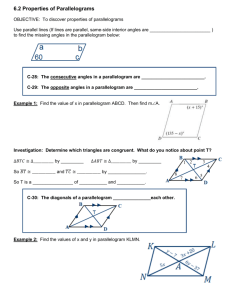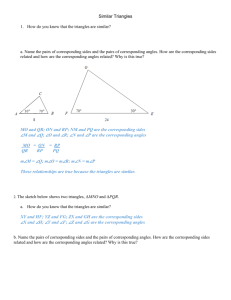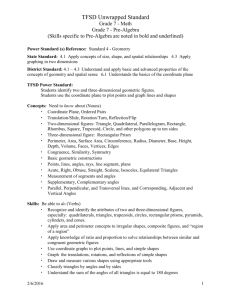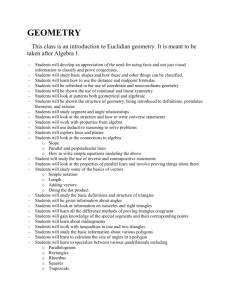Chapter 19 Developing Measurement Concepts
advertisement
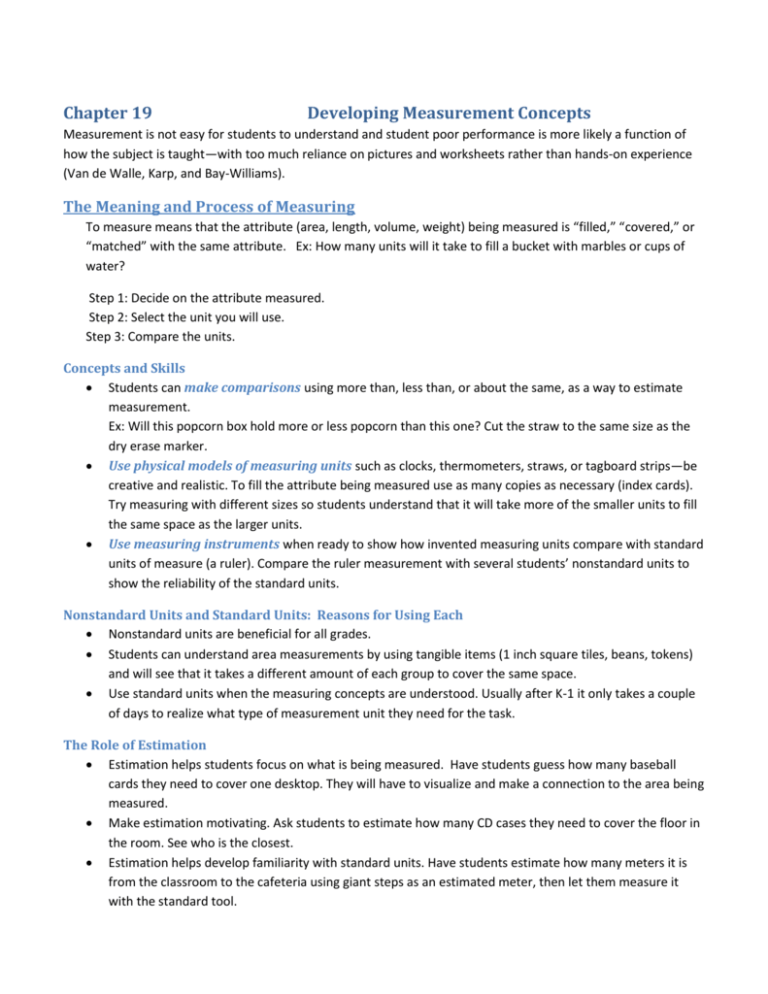
Chapter 19 Developing Measurement Concepts Measurement is not easy for students to understand and student poor performance is more likely a function of how the subject is taught—with too much reliance on pictures and worksheets rather than hands-on experience (Van de Walle, Karp, and Bay-Williams). The Meaning and Process of Measuring To measure means that the attribute (area, length, volume, weight) being measured is “filled,” “covered,” or “matched” with the same attribute. Ex: How many units will it take to fill a bucket with marbles or cups of water? Step 1: Decide on the attribute measured. Step 2: Select the unit you will use. Step 3: Compare the units. Concepts and Skills Students can make comparisons using more than, less than, or about the same, as a way to estimate measurement. Ex: Will this popcorn box hold more or less popcorn than this one? Cut the straw to the same size as the dry erase marker. Use physical models of measuring units such as clocks, thermometers, straws, or tagboard strips—be creative and realistic. To fill the attribute being measured use as many copies as necessary (index cards). Try measuring with different sizes so students understand that it will take more of the smaller units to fill the same space as the larger units. Use measuring instruments when ready to show how invented measuring units compare with standard units of measure (a ruler). Compare the ruler measurement with several students’ nonstandard units to show the reliability of the standard units. Nonstandard Units and Standard Units: Reasons for Using Each Nonstandard units are beneficial for all grades. Students can understand area measurements by using tangible items (1 inch square tiles, beans, tokens) and will see that it takes a different amount of each group to cover the same space. Use standard units when the measuring concepts are understood. Usually after K-1 it only takes a couple of days to realize what type of measurement unit they need for the task. The Role of Estimation Estimation helps students focus on what is being measured. Have students guess how many baseball cards they need to cover one desktop. They will have to visualize and make a connection to the area being measured. Make estimation motivating. Ask students to estimate how many CD cases they need to cover the floor in the room. See who is the closest. Estimation helps develop familiarity with standard units. Have students estimate how many meters it is from the classroom to the cafeteria using giant steps as an estimated meter, then let them measure it with the standard tool. Connect the measurements with multiplicative reasoning to meet benchmarks. Emphasize the use of approximate language using “about,” “a little less than,” or “nearly the same as” when estimating. NCTM standards state students in grades 3 - 5 should understand that measurements are approximations and different units of measure affect precision. Grades 6 – 8 should be able to select and apply techniques and tools to accurately produce the correct length, area, volume, and angle measure. Length Comparison Activities Use direct comparison with K students. Have them place different objects in order from smallest to largest. Use straight and wiggly lines to have them choose which path will take longer to walk. Use sidewalk chalk as a fun activity to have them test it by walking it to see who finishes first. Units of Length Use nonstandard units like giant footprints, jump ropes, connecting cubes or straws. Rather than giving a problem and directing students in how to solve it, let the students choose from a few options of units and compare with other groups using similar units (same size). Ask why the answers are different and how they might all get answers that are the same. Talk about precision and overlapping. Repeat the activity using different sized units and ask which group had to use the least amount of units. Use this in upper grades to introduce conversion of units-inches to feet, oz. to lbs. Explain fractional parts of units by suggesting students use smaller units to fill in the leftover gaps when measuring length or area. Older students can change the gap into a fraction. Making and Using Rulers Have students make their own ruler using two different colors of precut 1-inch pieces. Use an AB pattern. Each color is one unit. Ask how many units his/her pencil is. Let them place the pencil at any beginning unit. If they begin with one unit on the right spot, the answer will be the same and they will show they understand what one unit is. Once they understand this concept, let them number the ruler. As the grade level increases, have the students turn the ruler level into a number line—being sure, they begin with 0. Later, move on to the standard ruler and show how they are used in the same way. Area Comparison Activities Have students rearrange areas by cutting one shape into 2 pieces and making a new shape. Use tangrams. Units of Area Use pennies, beans, plastic chips, or square tiles to fill in small areas. Use newspaper for large areas. Use units that will fit without leaving leftover spaces until 4th grade. Allow students time to develop the concept of “covering the area” before giving formulas. 4 th grade will begin using multiplicative skills on their own while others are still filling in area with smaller units. Use grids to model how one whole side becomes a unit and can be multiplied by the other side as a whole unit. Similar to how they broke down fractions. The Relationship Between Area and Perimeter Using grid paper, have students shade in a square or rectangle-shading in a specific amount of squares. Count the squares that outline the shape and record it as the fixed area or fixed perimeter. Now count all the shaded squares—this is the area. Compare with others. They should observe different perimeters, but the same area. Volume and Capacity Comparison Activities Focus on capacity with lower grades. Use containers of different sizes and shapes. Fill with sand, rice, water, etc. Pour filled containers into a separate container and mark on the outside each result and make a record to compare least to greatest. Which holds more? Compare volume by using one container filled with rice only-pour into another-place apple or ball in empty container and fill the rest with rice. Now empty the rice in a third container. What was the volume of the apple? It will be the difference in the two containers holding the rice. Units of Volume and Capacity Use both solid objects and empty containers. Work towards using measuring cups. Weight and Mass Comparison Activities Younger children can use scales and estimation for selecting the heaviest object. Units of Weight and Mass Students should practice balancing small items on the scales—paper clips, erasers, washers, etc. Time Duration To get a visual idea of time, have students spin tops or hop on one foot to see who hopped the longest. Have one student start after the others and ask why he seemed to hop the longest. Use different comparisons. Which takes longer, brushing your teeth or riding to school? Clock Reading Begin by using one-handed clocks. Focus on hours and near the hours. Introduce minute hands counting by 5s. Use time “after the hour”. Move on to individual minute units and connect to digital clocks. Elapsed Time Use “counting on” by 5s to estimate elapsed time. Count hours first, then minutes. Suggest using a timeline for visual connections. Mark 12 noon and explain it begins p.m. Model 11:30 a.m. to 1:30 p.m. Money Coin and Recognition and Values Students will learn through exposure and repetition. This is one area that they need to be told. Counting Sets of Coins It easier for children to understand by explaining it as counting by 5s and 10s, then just add the 1s. Angles Comparison Activities Compare wide angles with short sides to narrow angles with long sides. Place on top of each other. Units of Angular Measure Cut out wedges and compare to one large angle. Explain unit angles fill in areas just like unit lengths. Move on to measuring tools, being sure to explain how to use them. Using Protractors and Angle Rulers Estimate angles first using a mental image-the rational number wheel. Focus on benchmark angles. Move on to protractors and angle rulers. This should eliminate unreasonable readings for angles. Introducing Standard Units Instructional Goals Unit Familiarity. Standard units should replace nonstandard units using comparisons. One benchmark for length is a comparison with the body parts. Choosing appropriate units. Use common sense. It is easier to measure a large area with the larger unit. Precision requires the addition of using the smaller unit. Important Standard Units and Relationships Knowledge of relationships between units. Inches to feet, ounces to pounds. Students will need to be told the relationships between the metric and customary systems. Introduce the metric system when decimal concepts are understood. Use friendly conversions for comparisons between the two systems, approximations will work. Estimating Measures Strategies for Estimating Measurements Develop and use benchmarks for important units. Ex: Use height of body for estimating. Easy visualization. Use “chunking” when appropriate. Ex: How much one book weighs is used to estimate a stack of books. Use subdivisions. Ex: Mentally divide the object being measured in ½ or ¼ s to until manageable. Iterate a unit mentally or physically. Ex: Mark off units visually by using hand and finger widths as guides. Tips for Teaching Estimation It is helpful to keep a class chart to use for reference ideas of estimating measurements. Teach children specific strategies then allow them to use their own techniques. Reasonable estimates would b within 10 of length and 30% of weight and volume. Post morning problem of estimation and talk about it later-only 5 minutes-not a complete lesson Measurement Estimation Activities Select different attributes each day. Use an object for circumference one day, switch to area another day, distance on another-this helps students to determine appropriate units for measuring. Developing Formulas for Area and Volume Students’ Misconceptions Students confuse formulas for area and perimeter because the concepts have not been understood. If area has been learned as a rote formula of length times width before exploring with visualization and manipulatives, then base times height makes no sense if the object is slanted. Explain that base will be a flat surface the object rests on and height is how tall the door of opening needs to be for the object to fit through. After this is understood, the formulas can be applied Areas of Rectangles, Parallelograms, Triangles, and Trapezoids Rectangles should be seen as arrays. Move on to measuring the length of one side as a “base” and the other as the “height.” Show A = b x h and show it will work using any two connecting sides no matter which way they turn it. Parallelograms should be taught using visual aids first. Show how to form a rectangle out of a parallelogram then explain it is the same at A = b x h. Triangles can be cut out and matched to form a parallelogram. Allow students to discover how to do this on their own. Use congruent triangles. If it took two triangles to make one parallelogram, take on triangle off the mat, leaving only one-half of the area to be measured. Once the concept is understood, add the formula of A – ½ (base x height). Trapezoids can be moved about like triangles. Place two trapezoids together to form a parallelogram and then measure (base x height). Cut out the rectangle and rearrange the end triangles, add triangles to the end of the rectangle and then measure (base x height). Students should visually see the relationship. Circumference and Area of Circles For circumference, students use wedges of a circle and rearrang to form a pattern like a parallelogram. Estimate the area using A = b x h. The narrower the wedges are, the closer the estimate will be. Students will need to be taught what circumference is and what diameter is before any formula is given. This could be done using yarn to measure the circumference, then the diameter. If students lay out the yarn to make a base and a height they can estimate the area of the circle. Show how the circumference is a little more than 3 time the diameter. Then explain preciseness of pi. Then introduce C = 𝜋D. Surface Area can best be learned in a hands on approach so students can see that the 3-d objects have many surfaces that need to be measured. Have students make their own 3-d shapes using cardstock paper. Use Velcro to connect the sides so students can take them apart to measure each surface. Add the total of each surface measurement together to get the area. Make it fun! Volumes of Common Solid Shapes Volumes of cylinders could best be illustrated using an empty box or cube. Place individual cubes on the bottom in rows as they did with the area of the squares. Write down the area of the base. Then stack the rows and count how many rows it take to fill the box. Write down the rows. Show how they can multiply the rows times the base to get the volume. If 15 squares covered the base and 6 layers or rows were needed to fill the cube, then 15 x 6 is the same as saying V(volume)=A x h. Volumes of cones and pyramids-First measure the base and the height of the cone. Use the fill and transfer method to fill an ice cream cone with rice and pour it into a square container that has the same base and height. Ask how many times they filled the cone to fill the cylinder? It should be 3. Connect as a ration of-3 to-1. Conclude that V = h x b/3.


